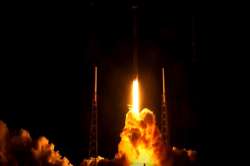SpaceX successfully deploys 60 starlink satellites, watch videos
Elon Musk's SpaceX has launched 60 rockets carrying internet satellites, achieving rare feet in the science and technology world. However, in a bid to appease stargazers, this time, some satellites have been coated dark to lessen reflectivity.

Science and Technology giant SpaceX achieved a rare-feet on late Monday when it launched 60 mini internet satellites, this time testing a dark coating to appease stargazers. It's a "first step" compromise between SpaceX and astronomers fearful of having dark skies spoiled by hundreds and, eventually, thousands of bright satellites circling overhead.
The Falcon 9 rocket blasted into a cold, clear night sky, recycled by SpaceX for its fourth flight. As the first-stage booster flew to a vertical landing on an ocean platform, the Starlink satellites continued hurtling toward orbit to join 120 similar spacecraft launched last year. Flight controllers applauded, and the launch commentator described the booster’s fourth touchdown as "awesome."
His Starlink fleet now numbering 180, SpaceX founder and chief executive Elon Musk plans to ultimately launch thousands of these compact flat-panel satellites to provide global internet service. Each spacecraft is just 575 pounds (260 kilograms).
SpaceX came up with darkening treatment to lessen reflectivity
After the first Starlink batch of 60 was launched in May and the second in November, astronomers complained how the bright satellite chain was hampering their observations. In response, SpaceX came up with a darkening treatment to lessen reflectivity. The coating is being tested on one of the newly launched satellites.
Jeff Hall, director of the Lowell Observatory in Flagstaff, Arizona, said the Starlinks have been just an occasional problem — so far — but noted the risk to stargazing will grow as the constellation expands and other companies launch their own fleets. He heads the American Astronomical Society’s committee on light pollution, space debris, and radio interference, and is working with SpaceX on the issue. The matter is on the agenda, in fact, at the society’s conference in Hawaii this week.
“Anything that darkens the satellites is a step in the right direction,” Hall said in an email Monday. He said it’s too soon to know whether the dark coating will work, “but it definitely is just a first step and not enough to mitigate the issues astronomy will experience with the Starlinks.”
The Starlinks are initially placed in a relatively low orbit of 180 miles (290 kilometeters), easily visible as a long, strung-out cluster parading through the night sky. Over a few months, krypton-powered thrusters raise the satellites to a 340-mile (550-kilometer) orbit.
The higher the orbit, the less visible the satellites are from the ground, according to SpaceX. Even so, SpaceX said it’s supplying astronomy groups with the satellite coordinates in advance, so they can avoid the bright flyover times.
Already established in launching satellites for others and making space station deliveries for NASA, SpaceX is among several companies looking to provide high-speed, reliable internet service around the world, especially in places where it’s hard to get or too expensive. Others include Jeff Bezos’ Amazon and OneWeb.
SpaceX may start service later this year in the northern US and Canada, then expand to the world’s most populated areas after 24 launches.
ALSO READ: Wolf moon eclipse on January 10: Where to watch, timing of the first lunar eclipse of 2020
ALSO READ: Florida woman dials 911 neighbourhood parrot screams 'let me out'